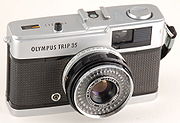
Olympus Trip 35
Encyclopedia

135 film
The term 135 was introduced by Kodak in 1934 as a designation for cartridge film wide, specifically for still photography. It quickly grew in popularity, surpassing 120 film by the late 1960s to become the most popular photographic film format...
compact camera, manufactured by Olympus
Olympus Corporation
is a Japan-based manufacturer of optics and reprography products. Olympus was established on 12 October 1919, initially specializing in microscope and thermometer businesses. Its global headquarters are in Shinjuku, Tokyo, Japan, while its USA operations are based in Center Valley, Pennsylvania,...
. It was introduced in 1967 and discontinued, after a lengthy production run, in 1984. The Trip name was a reference to its intended market – people who wanted a compact, functional camera for holidays. During the 1970s it was the subject of an advertising campaign that featured popular British photographer David Bailey. Over ten million units were sold.
The Trip 35 was a point and shoot model, with a solar-powered selenium
Selenium
Selenium is a chemical element with atomic number 34, chemical symbol Se, and an atomic mass of 78.96. It is a nonmetal, whose properties are intermediate between those of adjacent chalcogen elements sulfur and tellurium...
light meter
Light meter
A light meter is a device used to measure the amount of light. In photography, a light meter is often used to determine the proper exposure for a photograph...
, and just two shutter speeds. In 'A' mode, the camera operated as a Program automatic, choosing either 1/40th sec or 1/200th sec. The camera could also sync with flash, and had a range of aperture settings, from f2.8 to f22. In flash sync mode the shutter was set at 1/40. Apart from a simple four-position zone focus system, and an ISO setting
Film speed
Film speed is the measure of a photographic film's sensitivity to light, determined by sensitometry and measured on various numerical scales, the most recent being the ISO system....
from 25–400, the camera had no other photographic controls. The camera had a Prontor-Compur
Prontor-Compur
A Prontor-Compur connection is a standard 3.5 mm electrical connector used in photography to synchronize the shutter to the flash....
sync connector and a hot shoe
Hot shoe
A hot shoe is a mounting point on the top of a camera to attach a flash unit.- Design :The hot shoe is shaped somewhat like an inverted, squared-off "U" of metal. The matching adapter on the bottom of the flash unit slides in from the back of the camera and is sometimes secured by a clamping screw...
. Its lens was a coated Zuiko 40mm f/2.8, with four elements in three groups.
The camera had an ISO range of "only" 25–400, but this was acceptable, as films faster than 400 were uncommon and not of high image quality. 25 speed allowed the use of Kodachrome, while 400 speed allowed use of Tri-X and similar fast materials under low light.
The four-element Tessar lens, still impressive today, gave high-quality images. If used with modern film emulsions, the results can be very good.
The use of a selenium photocell to select the shutter speeds and aperture let novices use the camera as a "point & shoot", with good results obtained most of the time. And no battery was needed to power the camera, an important consideration when travelling where batteries might not be available.
The lack of more than two shutter speeds was not a problem. At 1/200 and f:22 with 400-speed film, the camera could deliver correct exposure in full sunlight, while at 1/40 and f:2.8, correct exposure could be obtained under bright fluorescent light, without a flash.
The aperture could also be adjusted to cope with sunny/dull conditions etc, so again this allowed for better results, but in low light conditions, with perhaps a smallish aperture (for long depth of field), the camera would probably set itself to the lower speed of 1/40th, so camera shake was a possibility if higher-speed film was not used.
Ken Rockwell recommends this camera as a very good option if you want to buy a cheap rangefinder camera
Rangefinder camera
A rangefinder camera is a camera fitted with a rangefinder: a range-finding focusing mechanism allowing the photographer to measure the subject distance and take photographs that are in sharp focus...
– though he actually states that "The ridged window to the right of the finder window is fake, mimicking a rangefinder." In his summary of the camera, he claims that the image quality compares favourably with his Canon EOS 5D
Canon EOS 5D
The EOS 5D is a 12.8 megapixel digital single-lens reflex camera body produced by Canon. The EOS 5D was announced by Canon on August 22, 2005, and at the time was priced above the EOS 20D but below the EOS-1D Mark II and EOS-1Ds Mark II in Canon's EOS digital SLR series...
.
External links
- www.olympus-trip.co.uk – A website dedicated to the Olympus Trip 35 camera
- A modification that allows a 1/200 shutter speed with manual aperture control
- www.olympuszuiko.com – another site with information and pictures of the Olympus Trip 35
- Olympus Trip 35 Service Manual with Photographs & Videos
- Caught in the Light: A photographer who has used the Olympus Trip 35 extensively for street photography

